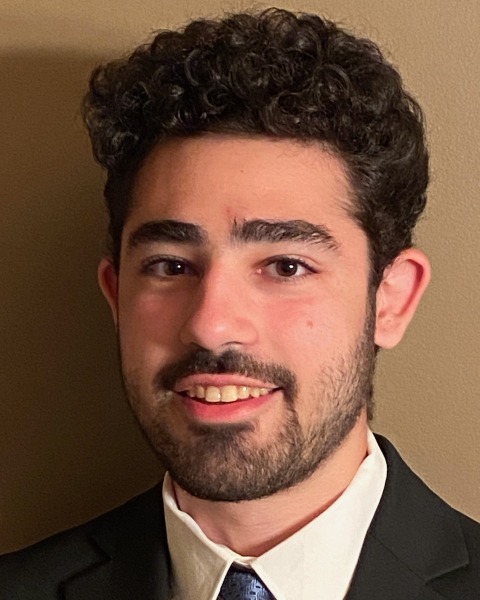Biomaterials
Biomaterials - Poster Session B
Poster C9 - Fabrication of Anisotropic Microparticles with Varying Aspect Ratios Via Photolithography for Granular Hydrogel Formation
Thursday, October 24, 2024
2:45 PM - 3:45 PM EST
Location: Exhibit Hall E, F & G

Dean Stornello
Biomedical Engineering Undergraduate Researcher
Purdue University
Lake Zurich, Illinois, United States
Taimoor H. Qazi, PhD
Primary Investigator & Professor
Purdue University, United States
Presenting Author(s)
Primary Investigator(s)
Introduction: Granular hydrogels are highly desirable as scaffolds for tissue engineering due to their inherent porosity, injectability, and tunable design features. Prior work in the field has shown that the morphology and arrangement of particles within granular hydrogels directly impact their structural properties and elicit differential cell responses [1]. In particular, increasing the particle aspect ratio to make rod-like particles can impart directional porosity and enhance cell migration and proliferation [2]. Anisotropic particles are typically fabricated using a microfluidics device, which affords limited control over droplet size and does not allow precise tuning of aspect ratios. In the present study, we explored the fabrication of anisotropic rod-like particles using a photo-responsive hyaluronic acid hydrogel system and a photolithography approach with custom-made photomasks. Particles with aspect ratios 2, 6, and 10 with a constant cross-sectional area were fabricated and the porosity and extrudability of granular hydrogels made with these particles were characterized.
Materials and
Methods: Norbornene-modified hyaluronic acid (NorHA) was synthesized as previously reported [3]. A precursor solution of NorHA, DTT (crosslinker), and LAP (photointiator) was sandwiched between two Sigmacote-treated glass slides separated by 130 μm spacers. Custom-made photomasks with an array of transparent rod shapes (FineLine Imaging) was positioned above the glass slide and this setup was placed under UV (40 mW.cm-2) for 6 seconds to crosslink the exposed regions. Particle morphology was evaluated using fluorescence microscopy (after inclusion of a FITC-dextran dye within the particles). Non-fluorescent particles were dispersed in a FITC-dextran solution and jammed via centrifugation at 5000 rcf for 5 minutes to create a granular hydrogel pellet. Samples were transferred to a PDMS mold and imaged using a Zeiss LSM800 confocal microscope to visualize FITC-dextran inside inter-particle pore spaces. Pore features were quantified using the particle size analyzer function on ImageJ. Extrudability and extrusion force measurement was performed using an Arduino-based force measurement setup and a force-resistive sensor, as described before [3]. Data were analyzed in Graphpad Prism and results were tested for statistical significance using one-way ANOVA with Tukey’s post-hoc comparison.
Results, Conclusions, and Discussions: NorHA hydrogel microparticles were fabricated via photolithography with target aspect ratios (AR) of 2, 6, and 10. The experimentally obtained particles had aspect ratios of 1.98, 5.93, and 10.06, closely matching the photo-pattern aspect ratios with some variability in size, which can be attributed to particle chipping due to mechanical handling and particle swelling during washing (Fig. 1c). Granular hydrogels made with AR6 particles had a significantly higher porosity (~15%) compared to those made with AR2 and AR10 (both ~11%) (Fig. 1d). Extrudability testing revealed unique particle properties where AR10 particles did not fracture under needle extrusion forces and each AR group had no significant difference between average mean extrusion force (ranging from 0.36-1.06 N), indicating the viability of these aspect ratio particles in medical applications consistent with other injectable granular hydrogels (Fig.1e). While the photolithography approach has a lower particle yield and produces minimal amounts of smaller gel debris (which can impact scaffold porosity) compared to microfluidics and is a time-consuming process, it affords the ability to precisely vary pattern design and obtain particles with well-defined aspect ratios. Taken together, the results expand the biomaterial design space for creating granular hydrogels with tunable particle aspect ratios for potentially broad applicability in tissue engineering applications. Ongoing and future work will investigate how particle aspect ratio impacts cell morphology and migration behavior.
Acknowledgements (Optional): References
[1] Suturin, A. C., Krüger, A. J. D., Neidig, K., Klos, N., Dolfen, N., Bund, M., Gronemann, T., Sebers, R., Manukanc, A., Yazdani, G., Kittel, Y., Rommel, D., Haraszti, T., Köhler, J., & De Laporte, L. (2022). Annealing High Aspect Ratio Microgels into Macroporous 3D Scaffolds Allows for Higher Porosities and Effective Cell Migration. Advanced healthcare materials, 11(24), e2200989. https://doi.org/10.1002/adhm.202200989
[2] Qazi, T. H., Wu, J., Muir, V. G., Weintraub, S., Gullbrand, S. E., Lee, D., Issadore, D., & Burdick, J. A. (2022). Anisotropic Rod-Shaped Particles Influence Injectable Granular Hydrogel Properties and Cell Invasion. Advanced materials (Deerfield Beach, Fla.), 34(12), e2109194. https://doi.org/10.1002/adma.202109194
[3] Muir, V. G., Qazi, T. H., Shan, J., Groll, J., & Burdick, J. A. (2021). Influence of Microgel Fabrication Technique on Granular Hydrogel Properties. ACS biomaterials science & engineering, 7(9), 4269–4281. https://doi.org/10.1021/acsbiomaterials.0c01612
